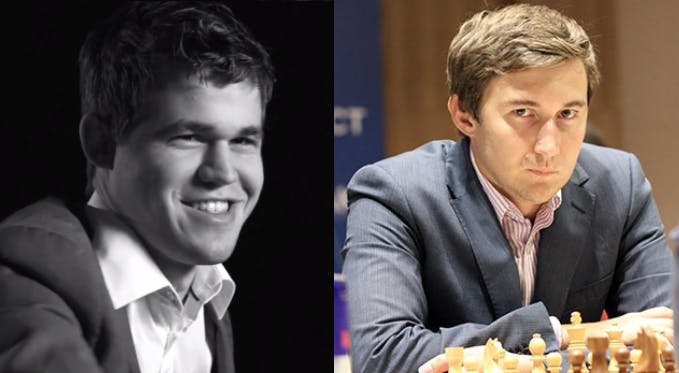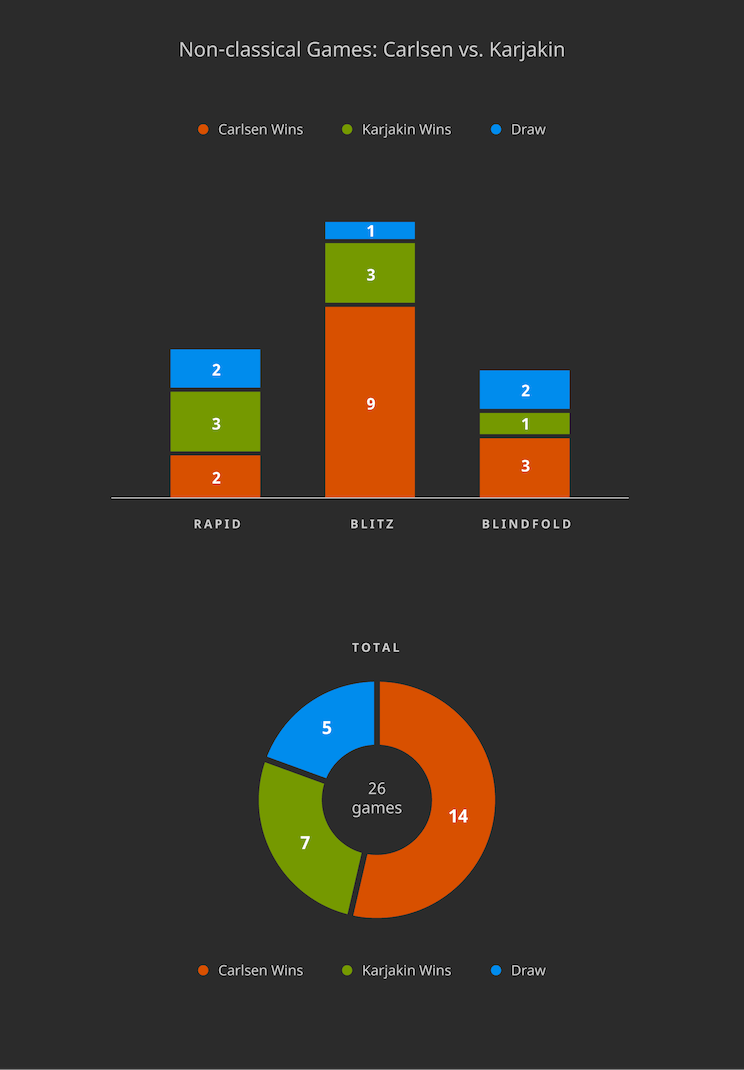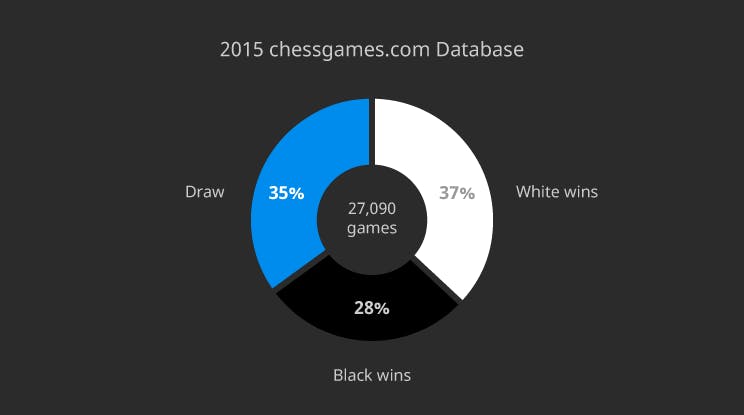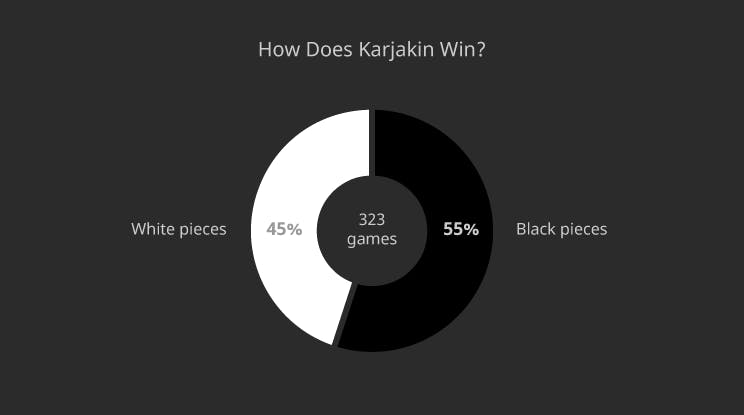Carlsen and Karjakin Battle for Chess Immortality
2 Grandmasters, raised with computers, will battle on chess's most coveted stage: The World Championship.


On November 11th, 2016, in New York’s South Street Seaport, World Champion Magnus Carlsen will make his first move against Sergey Karjakin and begin the youngest World Championship match in history. Carlsen became World Champion in 2013 when he defeated Viswanathan Anand in their match without losing a game. Carlsen also won the 2014 rematch against Anand. Karjakin earned his seat by winning the 2016 Candidates Tournament, capped with a brilliant win over US #1 Fabiano Caruana. At the beginning of the match, Carlsen’s rating is 2853 and #1 in the world, while Karjakin stands at 2772, putting him at #9.
The Venue
Chess is in the DNA of New York. A keen eye can find a gang of chess players in most New York City Parks. The players in the park are a microcosm of the city surrounding them: Wall St Millionaires battling street hustlers, cocky college students getting lessons in humility from cranky experts. New York and Chess have this in common: It’s not who you are, it’s your moves that define you.
New York hosted the 1995 World Championship match between Garry Kasparov and the aforementioned Anand at the World Trade Center. The last American World Champion was the brilliant recluse Bobby Fischer, who won the title in Reykjavik in 72’ against Boris Spassky.
The Match
The World Championship Match is best of 12 games. Players will play 1 game a day, for 2 days, then enjoy a rest day. If the score is tied after 12 games the players with play 4 rapid games, 5 2-Game blitz matches, and if necessary, an armageddon game. In addition to the title of “World Champion,” there is a $1.1 million USD prize pool at stake.
The Cold Hard Numbers
Carlsen and Karjakin have faced each other 21 times in Classical Chess (100 minutes for the first 40 moves, 50 minutes for the next 20 moves and then 15 minutes for the rest of the game plus an additional 30 seconds per move starting from move 1). Carlsen has won 4, Karjakin has won 1, while 16 games ended in a draw.
2 pieces of bad news for Karjakin: 1. The last time Carlsen lost to Karjakin in a classical game was in 2012. 2. Karjakin was soundly beaten in their last encounter earlier in 2016. The game features Carlsen masterfully finding the optimal square for each of his pieces, while Karjakin seemed confused, moving his kingside rook 6 times in just 26 moves . Frankly, the data from their classical games paints a bleak picture for the Russian challenger.
The results from their non-classical (rapid, blitz, and blindfold) matches is a bit more interesting, and may reveal insights on how Karjakin could win the match. Here’s the data for all the Carlsen vs Karjakin non-classical games.

Magnus leads Karjakin in three out of four categories. How big of a favorite is Carlsen? The “Vegas Odds” have a 78% chance of Magnus retaining his title.
Karjakin, Staunch Defender
A deeper look at the data reveals some interesting patterns, particularly for Karjakin. In Chess the white side goes first, and has the advantage because of it. At top level chess the player with the black pieces is at a disadvantage and usually happy with a draw while the white side wants to use their advantage to play for a win. Here’s a chart that shows all the games from 2015 in chessgames.com, as you can see, black winning is the least likely game outcome.

Here’s the interesting point: Karjakin beats Carlsen more with black than he does with white. Out of their 47 games, Karjakin won 8 games, 6 games with black, only 2 with white. The only time Karjakin beat Carlsen in a classical game, way back in 2012, was with the black pieces. Karjakin’s unusual penchant for winning with black more than white isn’t isolated to Carlsen, here is a chart of Karjakin’s wins against other Super Grandmasters:

The data reveals Karjakin’s core strength: Staunch Defense. A quality shared with past Champions like Botvinnik, Karpov, and Spassky, to name a few. Karjakin has gotten to the World Championship by understanding his opponent's moves better than they do themselves. A great example of this type of mindset can be seen in the last game of the 2016 Candidates Match, the very game that earned Karjakin his ticket to New York. Karjakin has the white pieces, and Caruana the black pieces. Caruana is desperate, if he beats Karjakin he will play Magnus for the World Championship, but a loss or draw sends Karjakin. What does Karjakin do? He let Caruana recklessly attack him, as Caruana had to risk his king safety in this attack. When the moment was right, Karjakin decimated Caruana’s position with a mysterious rook sacrifice, ending the game only a couple moves later.
This mindset has applications in many sports: Making the second move is an advantage because you get to make your move with more information than your opponent. In blackjack, the house is revealed last and casinos make billions of dollars every year. The home team in baseball bats second. In No Limit Hold'em’, having "position" (acting last) is often times valued more than the quality of your cards. Would Karjakin have the best odds of winning the match if he got the black pieces in every game? The data says yes.
But for this strategy to work, Carlsen needs to make a mistake. Does Carlsen make mistakes? Yes, Carlsen famously blundered in the last World Championship Match against Anand. Unbelievably, Anand didn’t realize the mistake, and blundered right back to the relief of Carlsen:
https://lichess.org/study/kOdVPRDd/bb7ocqXt
Carlsen occasionally blunders against Karjakin, usually on move 38: 2008 Rapid Game, 2008 Blitz Game, 2010 Rapid Game.
Carlsen’s Suffocating Chess
The year is 2008, the World Champion is the Indian GM, Viswanathan Anand. His challenger is the Russian GM Vladimir Kramnik. The format for their match is the same as the 2016 format, best of 12 games. Anand has a reputation for having the most vast opening repertoire in chess. This means Anand is very good at memorizing thousands of chess openings 20, sometimes 30 moves into a game. Having such an encyclopedia available is an obvious advantage. Imagine Player “A” and player “B” have played 30 moves of their chess game. Player “A” had the first 12 moves of game memorized, and therefore had to think for 18 moves of the game. Player “B” had all 30 moves memorized, and has not had to think in the game yet. Player “B” has the advantages for many reasons, I’ll list three. The first advantage is player “B’s” moves will probably be better because they were conceived in the comfort of a study area, not OTB (over the board). The second advantage is mental stamina. Thinking and creating is hard work, just like running, turning a crank, or ditch digging. The longer you think, the less accurate your moves become. Imagine running a marathon against an opponent and he gets to ride in a golf cart alongside you for the first 10 miles while getting a back massage. The third advantage is mental. Players at this level can sense when they’re in someone’s ‘preparation’. It might be how fast a player is making their moves, it might be the off-beat, but strategically sound flavor to their moves. But the fact is, it’s not fun to walk into a trap, and it might make some lesser experienced players crack. In this aspect of chess, Viswanathan Anand is generally considered the best prepared.
In the 3rd game of Anand vs Kramnik, Kramnik had the white pieces and walked right into a memorized line of Anand, and lost the game. When asked about Anand’s play after the game Kramnik said he wasn’t impressed and challenged Anand to make the same moves the next time he had the white pieces. In game 5 Kramnik stubbornly made similar moves to game 3 and Anand happily played a slightly different line, and beat him again.
https://lichess.org/study/kOdVPRDd/NwKcnHMG
Anand’s preparation won game 3, but Kramnik’s hubris lost him game 5. These two games gave Anand an enormous advantage, and Anand went on to win the match. One could argue that the 2008 World Chess Championship was decided off the chessboard. Chess culture and history is shaped by occurrences like these. Opening preparation is of the utmost importance, and players are careful when and where to reveal brilliant lines they memorized at home. Certain openings become popular, while others fall out of fashion. That is the vernacular used by the chess community, an opening “falls in and out of style”. Many players have coaches specifically dedicated to preparing openings for them that will be especially effective against a certain opponent. Teams have been accused of leaking opening information. Massive resources and effort were and still are devoted to developing a player’s opening repertoire. How does Carlsen approach openings?
“(Carlsen) went into some games with only the first move chosen; most players typically map out their first dozen or so moves. He believes that things even out because, as he put it, “I’m younger and have more energy, and it’s easier to adapt.” -
T.D. Max, The New Yorker
Carlsen plays very simple openings, and almost never gets an advantage because of it. What he does get, is a neutralization of his opponent's opening preparation. No memorized lines, no ego, no accusing teams of leaking openings, Carlsen’s simple openings force his opponent’s into doing what Carlsen does best: play chess, and play chess until you crack.
The first game of the Carlsen vs Anand World Championship Match is a perfect illustration of this strategy. Carlsen trades off 3 minor pieces, and a pawn by move 13, avoiding any potential complications from his notoriously well prepared opponent. By move 27 they have already moved on to the endgame, Anand has a slight space advantage, Carlsen has a better pawn structure, the computer regards the position as exactly even. With neither side having any discernible advantage the game should end as a draw. But it’s precisely this dry, some would call boring, type of position that Carlsen wants. Over the next couple of moves we see Carlsen’s pieces jump into action, and begin the “strangling pressure, no direct hits”, which is how Garry Kasparov describes Carlsen’s style. In the end, Anand found a brilliant way to draw the game by a 3-fold-repetition, but the disturbing message was heard: Carlsen took a position of almost complete equality, and made a former World Champion bend, but not break.
Anand broke in game 2. Eerily similar position to game 1, rook and queen endgame. In game 2, Carlsen did have approximately a 1 pawn advantage, as opposed to the equality of game 1. But Carlsen used the same strategy of strangling pressure, and on move 34 Anand made a blunder that made spectators wince, he resigned on the next move.
This is the kind of style I expect to see from Carlsen in his match with Karjakin: patient moves that improve his own position, and pressure his opponent, while also creating no weakness that could be exploited. In short if you want to know what Carlsen plays chess like, watch Top Gun he’s “Iceman,” “(Iceman) Flies ice-cold. Makes no mistakes. Wears you down. You get bored, do something stupid, he’s got you.”
Computer’s Influence on Modern Chess
Computers used to be the laughing stock of the chess world. The were clunky monstrosities that could maybe string together a couple of good moves, but before long, the computer would make a move that was unbelievably bad. It was thought that the subtle moves, nuances, and instinct needed for chess would ultimately make computers unable to compete.
It’s difficult to tell when the tipping point happened, perhaps it was Garry Kasparov losing to IBM’s Deep Blue in 1997. But computers are now ubiquitous. Chess engines on your cell phone are able to calculate millions of moves a second, and totally understand mysterious positions with ease. The resources computers provide combined with the universal connection of the internet, changed the world of chess forever.
But how computers evaluate positions, decide who is winning and losing, have shaped how top level chess players think as well. A ‘computer move’ used to mean a comically illogical move so stupid, only a computer could have composed it. Now a ‘computer move’ means a move so illogically brilliant, no human could have conceived it.
Carlsen and Karjakin have grown up with computers and gleaned their unusual insights over their entire chess career. It is innate connection with computers that gives the younger generation of chess players the ability to play these ‘computer moves’ with more frequency than their seniors. I am always watching chess streams of big tournaments and commentators will say something like, “Well looking at this position, there are a lot of tactics and lots of ways to improve the position, but the computer is saying that the best way to continue is for white to simply move their king to b1, now of course that move won’t be played because it’s computer move.” Only to see the young player make the mysterious computer move to the shock of the commentator. This is the first time the world gets to see two chess players raised on computers face off for the world championship.
Expect Brilliance
It is difficult to predict what strategies Carlsen and Karjakin will bring to the table. Anand was a Champion for many reasons, but his opening preparation was his most feared weapon. Magnus defeated Anand with simplicity and youthful endurance. But what is the antidote for simplicity? Is there one? That is what Karjakin will try to answer.
Magnus does have a bad habit of starting tournaments badly, losing a couple of games, only to go on a win streak and win.
“Friedel wrote to me, “I have a new theory. Magnus is so strong that he is simply bored. (I know from personal experience that he bores easily.) So he has come up with a new strategy to make things more interesting for himself: play like an idiot in the first few games, move to the bottom of the table, and then try to win the tournament anyway.” T.D. Max, The New Yorker
Does Magnus deliberately ‘take a dive’ at the beginning of a tournament to challenge himself? He did make the objectively bad move 1.e3 in the 2016 Chess Olympiad, albeit against a much lower rated opponent. Magnus won that game in 33 moves.
https://lichess.org/study/kOdVPRDd/FoMRcnh0
But this is the World Championship, and to imagine either player approaching the match with anything but world class preparation would be difficult to imagine. With that said, Karjakin’s style is perfect for defending a match lead, and thus we come to the most logical way I can think for Karjakin to actually win: For whatever reason Carlsen starts the match off on the wrong foot, Karjakin seizes the lead, Carlsen is forced to play more aggressive than he normally would to regain the lead, and Karjakin is able to use Carlsen’s desperation against him, just like he did to Caruana at the end of the 2016 Candidates tournament. Although it is possible, I would say this is a highly unlikely series of events.
What would I predict? A conservative start to the match. Imagine a boxing match where the two competitors throw just a couple of jabs, not so much to connect and knock the opponent out, but to see how the opponent reacts. I predict Carlsen and Karjakin not to risk much, in the first couple games, but rather make some pressing moves to see how the opponent reacts.
But I would say the critical games will be a game where Carlsen has whites and Karjakin has the blacks. As both players win more with those colors.
I predict the final score 6 ½ Carlsen 4 ½ Karjakin, with Carlsen winning the 11th game.
Coverage
Lichess.org will be at every game, and will provide an immediate post-game article written by yours truly, Tyler Schwartz, along with commentary and insights from some of lichess’s top players.
Lichess.org is an open source, free chess website. Hourly tournaments, variants, analysis, player insights, puzzles are just a few of the features offered for free to every user. If you like lichess and want to support the site become a Patron!
About the Author: Tyler Schwartz is a passionate chess ambassador. Tyler is the President of Chess at 3, teaching chess to children all over the world at the suprising age of 3. He is the Head of Media at lichess.org. Tyler also manages a chess club on the upper east side of Manhattan. Graphics by Joshua Krohn.
Edits: 11.7- The last time Magnus lost to Karjakin was in 2012, not 2006 like orginally published
11.8- Prediction changed from 6.5-3.5 to 6.5-4.5 because of math.